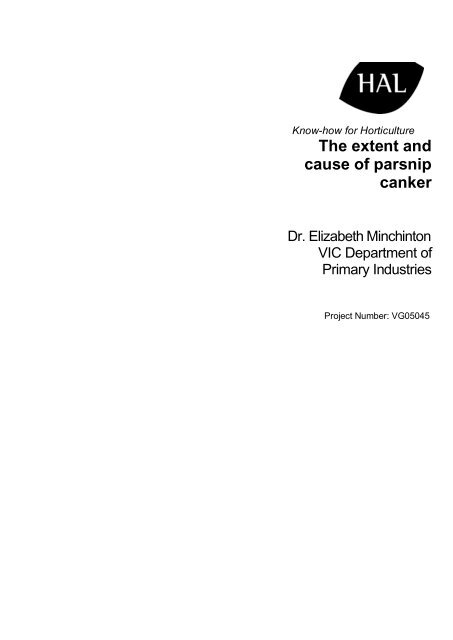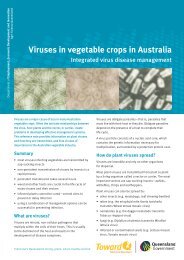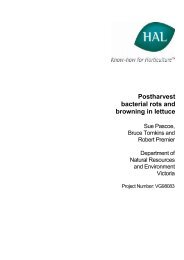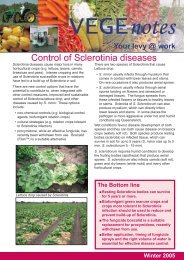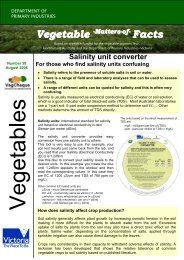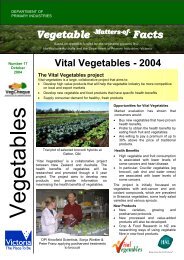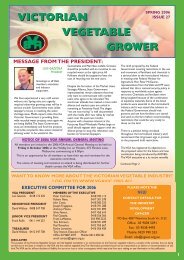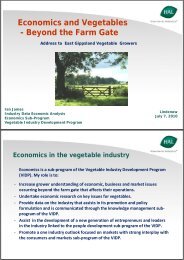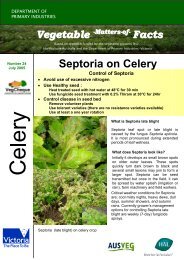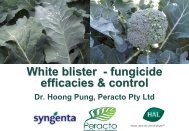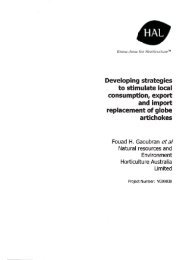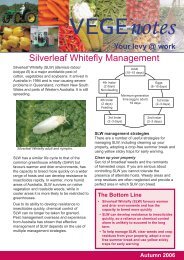The extent and cause of parsnip canker - Vegetable Growers ...
The extent and cause of parsnip canker - Vegetable Growers ...
The extent and cause of parsnip canker - Vegetable Growers ...
Create successful ePaper yourself
Turn your PDF publications into a flip-book with our unique Google optimized e-Paper software.
Know-how for Horticulture<strong>The</strong> <strong>extent</strong> <strong>and</strong><strong>cause</strong> <strong>of</strong> <strong>parsnip</strong><strong>canker</strong>Dr. Elizabeth MinchintonVIC Department <strong>of</strong>Primary IndustriesProject Number: VG05045
HAL Report VG05045Horticulture Australia Project No:Project Leader:Contact Details:Project Team:Address:VG05045Dr Elizabeth MinchintonDepartment <strong>of</strong> Primary Industries, Knoxfield CentrePrivate Bag 15, Ferntree Gully DC, Victoria 3156Tel: (03) 9210 9222Fax: (03) 9800 3521Email: liz.minchinton@dpi.vic.gov.auDesmond Auer, Fiona Thomson <strong>and</strong> Slobodan VujovicDepartment <strong>of</strong> Primary Industries, Knoxfield Centre,Private Bag 15, Ferntree Gully DC, Victoria 3156.Purpose <strong>of</strong> project:This report details the outcomes <strong>of</strong> a 24-month project investigating <strong>parsnip</strong> <strong>canker</strong>. This project carried outsurveys to investigate both the <strong>cause</strong> <strong>and</strong> <strong>extent</strong> <strong>of</strong> <strong>parsnip</strong> <strong>canker</strong> in Victoria, Western Australia <strong>and</strong> Tasmania.Report completed: January 2008Funding acknowledgments<strong>The</strong> researchers acknowledge the financial support for this project from Horticulture Australia Limited (HAL),AUSVEG, the Federal Government <strong>and</strong> the Department <strong>of</strong> Primary Industries.AcknowledgmentsWe acknowledge the financial contributions from the National <strong>Vegetable</strong> Levy (AusVeg), Horticulture Australia(HAL) <strong>and</strong> the Federal Government. We thank participating growers Peter, Darren <strong>and</strong> Paul Schreurs; RussellLamattina, Joe Kelly, <strong>and</strong> Silvio <strong>and</strong> Glenn Favero for supplying field sites <strong>and</strong> advice. We also thank MarkMilligan <strong>and</strong> Karl Riedel for their helpful discussions. <strong>The</strong> input <strong>of</strong> past <strong>and</strong> current state IDO’s is gratefullyacknowledged, including Alison Anderson (NSW), David Ellement (Western Australia), Craig Feutrill (SouthAustralia), Craig Murdoch (Victoria) <strong>and</strong> Stephen Welsh (Tasmania).DisclaimerThis publication may be <strong>of</strong> assistance to you but the State <strong>of</strong> Victoria <strong>and</strong> its <strong>of</strong>ficers do not guarantee that thepublication is without flaw <strong>of</strong> any kind or is wholly appropriate for your particular purpose <strong>and</strong> thereforedisclaims all liability for any error, loss or other consequence which may arise from you relying on anyinformation in this publication.Any recommendations contained in this publication do not necessarily represent current Horticulture Australiapolicy. No person should act on the basis <strong>of</strong> the contents <strong>of</strong> this publication, whether as to matters <strong>of</strong> fact oropinion or other content, without first obtaining specific, independent pr<strong>of</strong>essional advice in respect <strong>of</strong> thematters set out in this publication.© State <strong>of</strong> Victoria, Department <strong>of</strong> Primary Industries, 2008
HAL Report VG05045Table <strong>of</strong> ContentsTable <strong>of</strong> Contents ..................................................................................1Media Summary ....................................................................................2Technical Summary...............................................................................3Chapter 1 A brief history <strong>of</strong> <strong>parsnip</strong> <strong>canker</strong>..........................................4Chapter 2 Surveys <strong>of</strong> <strong>parsnip</strong> <strong>canker</strong> <strong>extent</strong> <strong>and</strong> <strong>cause</strong> for the years2006 <strong>and</strong> 2007 .................................................................................... 11Chapter 3 Pathogen tests .................................................................... 16Chapter 4 Field trials to complement pathogen tests......................... 22Chapter 5 Cultivar evaluation ............................................................ 30Chapter 6 Epidemiology..................................................................... 35Chapter 7 Technology transfer <strong>and</strong> recommendations ...................... 431
HAL Report VG05045Media SummaryGround breaking research into <strong>parsnip</strong> <strong>canker</strong> in AustraliaScientists have taken the first step in determining the <strong>cause</strong> <strong>and</strong> <strong>extent</strong> <strong>of</strong> <strong>parsnip</strong> <strong>canker</strong> inAustralian <strong>parsnip</strong> production. Parsnip <strong>canker</strong> can <strong>cause</strong> crop losses up to 80 %. Parsnip is along-term crop, harvested after 5–7 months. It is a difficult crop to grow <strong>and</strong> there are fewmajor growers in Australia. Victoria produces over 80 % <strong>of</strong> the total <strong>parsnip</strong> production inAustralia.Surveys <strong>of</strong> <strong>parsnip</strong> <strong>canker</strong> at harvest in 2006 <strong>and</strong> 2007 showed that <strong>canker</strong> levels peakedbetween September <strong>and</strong> November, on crops sown in February to March. <strong>The</strong> peak averagelosses due to <strong>canker</strong> for this period were 45 % for 2006 <strong>and</strong> 23 % for 2007. This represents apotential loss <strong>of</strong> A$3 million for the <strong>parsnip</strong> industry over the two years.Several fungi were isolated from <strong>canker</strong>s <strong>and</strong> there was strong evidence that the debilitatingdisease is <strong>cause</strong>d by more than one organism. <strong>The</strong> fungi isolated included Itersoniliaperplexans, the main <strong>cause</strong> <strong>of</strong> this disease overseas, <strong>and</strong> fungi such as Cylindrocarpon spp.,Fusarium spp., Mycocentrospora acerina, Pythium spp. <strong>and</strong> Rhizoctonia spp.Observations in the field, as well as laboratory studies, indicated that superficial damage tothe roots predisposed <strong>parsnip</strong>s to fungal attack <strong>and</strong> <strong>canker</strong>.Symptoms <strong>of</strong> <strong>parsnip</strong> <strong>canker</strong> are large black lesions on mature <strong>parsnip</strong> roots, mostly on theshoulder or crown that can spread to other sections <strong>of</strong> the root <strong>and</strong> in extreme cases, cover theentire root, making the product unusable.Information resulting from this research was presented in conference posters, at SteeringCommittee meetings <strong>and</strong> field days.This research was led by scientists at the Department <strong>of</strong> Primary Industries VictoriaKnoxfield Centre. <strong>The</strong> project was facilitated by Horticulture Australia Limited (HAL) inpartnership with Federation <strong>of</strong> Potato <strong>and</strong> <strong>Vegetable</strong> <strong>Growers</strong> Australia Limited (AUSVEG)<strong>and</strong> was funded by the National <strong>Vegetable</strong> Levy. <strong>The</strong> Australian Government providesmatched funding for all <strong>of</strong> Horticultural Australia’s Research <strong>and</strong> Development activities. <strong>The</strong>researchers gratefully acknowledge the financial support <strong>of</strong> the Department <strong>of</strong> PrimaryIndustries through Primary Industries Research Victoria.2
HAL Report VG05045Technical summaryLittle or no research into <strong>parsnip</strong> <strong>canker</strong> has been undertaken in Australia despite the fact thatgrowers have reported persistent crop losses in spring-harvested crops <strong>of</strong> up to 80 % for 40years.This 24 month scoping study: Surveyed <strong>parsnip</strong> crops in the major cropping regions <strong>of</strong> Victoria, Tasmania <strong>and</strong> WesternAustralia to identify the <strong>extent</strong> <strong>of</strong> <strong>parsnip</strong> <strong>canker</strong> affecting production; Identified the <strong>cause</strong>s <strong>of</strong> <strong>parsnip</strong> <strong>canker</strong> in Victorian crops by conducting pathogenicitytests (Koch’s postulates) on fungi isolated from <strong>canker</strong>s; Used field trials to confirm pathogen trials; Determined that root damage predisposed <strong>parsnip</strong> roots to <strong>canker</strong>.Systematic surveys involving four growers in Victoria, as well as one in Tasmania <strong>and</strong> two inWestern Australia showed that <strong>parsnip</strong> <strong>canker</strong> was a major problem in Australia. In Victoria,where 80 % <strong>of</strong> Australian <strong>parsnip</strong>s are grown, <strong>parsnip</strong> <strong>canker</strong> accounted for losses <strong>of</strong> up to 45% in spring-harvested crops, <strong>and</strong> in one case, losses were over 85 %. This represented apotential loss <strong>of</strong> A$3 million for the <strong>parsnip</strong> industry over two years.Pathogenicity tests were conducted on fungi that were consistently isolated from diseased<strong>parsnip</strong> roots in Victoria. <strong>The</strong> confirmed overseas pathogens Itersonilia perplexans,Cylindrocarpon spp., Mycocentrospora acerina <strong>and</strong> Phoma spp. all <strong>cause</strong>d <strong>canker</strong>-likesymptoms on fresh <strong>parsnip</strong> roots. Other fungi such as Acremonium spp., Fusarium spp.,Microdochium spp., Pythium spp. <strong>and</strong> Rhizoctonia spp. <strong>cause</strong>d similar lesions. Pathogen trialsalso established that root damage predisposed <strong>parsnip</strong> to pathogen attack.Trials involving growers’ own seed <strong>and</strong> a commercial variety, Tusk, showed that there waspotential to alleviate <strong>canker</strong> levels using resistant cultivars. <strong>The</strong> use <strong>of</strong> Tusk reduced <strong>canker</strong>levels by 45 % compared to some <strong>of</strong> the growers’ own seed stocks.<strong>The</strong> effectiveness <strong>of</strong> metalaxyl-m in one out <strong>of</strong> three trials, in reducing <strong>canker</strong> incidence by77 %, reinforced the notion <strong>of</strong> root damage contributing to <strong>parsnip</strong> <strong>canker</strong>. In a second trial,metalaxyl-m reduced <strong>canker</strong> incidence by 34 %, although, in this case, it was not significantlydifferent from the control. <strong>The</strong>se results, as well as the pathogen tests, indicate that oomycetefungi such as Pythium spp. may have a role in predisposing <strong>parsnip</strong> roots to <strong>canker</strong>.Future directionsOur research has increased knowledge <strong>of</strong> <strong>parsnip</strong> <strong>canker</strong> but it has revealed how little weknow about this disease complex.Future investigations need to determine the: Predisposing nature <strong>of</strong> Pythium species <strong>and</strong> other pathogenic fungi; Biological succession <strong>of</strong> fungi on <strong>parsnip</strong> root to determine the time <strong>of</strong> initialinfection, by microbiological sampling; Influence <strong>of</strong> predisposing abiotic factors such as soil moisture, temperature, pH,nutrients <strong>and</strong> fertilization on <strong>canker</strong> development; Initiation <strong>of</strong> field infections, using targeted fungicides; Cultural, biological <strong>and</strong> alternative s<strong>of</strong>t chemical controls.3
HAL Report VG05045Chapter 7Technology transfer <strong>and</strong> recommendationsSummaryThis chapter reports the benefits <strong>of</strong> a project advisory group established to oversee research projects.This group increased communication <strong>and</strong> cooperation between growers, researchers <strong>and</strong> allied supportbusinesses <strong>and</strong> resulted in an accelerated impact <strong>of</strong> research <strong>and</strong> development within the <strong>parsnip</strong>industry. Recommendations for future research are presented.7.1 Introduction<strong>The</strong> research reported herein is the result <strong>of</strong> collaboration between <strong>parsnip</strong> growers, industry advisorygroups <strong>and</strong> project steering committees. <strong>The</strong>se groups consisted <strong>of</strong> vegetable growers, cropconsultants <strong>and</strong> chemical resellers, with diverse experiences which they brought to the project. <strong>The</strong>groups provided an opportunity for researchers to describe their approach <strong>and</strong> current progress thuspromoting the impact <strong>of</strong> research <strong>and</strong> development projects. <strong>The</strong> advisory groups also enabledgrowers <strong>and</strong> allied industries to ensure that their needs were being met by the research project. <strong>The</strong>advisory group approach worked very well <strong>and</strong> is DPI’s preferred method <strong>of</strong> involvement with thevegetable industry. This interaction <strong>and</strong> collaboration with growers <strong>and</strong> vegetable industrydevelopment <strong>of</strong>ficers (IDOs), along with the subcontracting <strong>of</strong> sections <strong>of</strong> work to industry expertshas been <strong>of</strong> enormous benefit to the project. <strong>The</strong> IDOs identified <strong>parsnip</strong> growers in other states. <strong>The</strong>advisory committee encouraged the researchers to promote results <strong>of</strong> the research to growersnationally in industry publications.7.2 Industry advisory group<strong>The</strong> Department <strong>of</strong> Primary Industries Victoria took the approach <strong>of</strong> inviting growers <strong>and</strong> privateallied support business representatives to volunteer their time <strong>and</strong> join with researchers to plan <strong>and</strong>discuss <strong>parsnip</strong> disease issues first h<strong>and</strong>. Not all growers were in the position <strong>of</strong> being able tovolunteer their time due to the dem<strong>and</strong>s <strong>of</strong> growing <strong>and</strong> marketing vegetables <strong>and</strong> consequently theresearchers are extremely grateful to those who were able to contribute. <strong>The</strong> <strong>parsnip</strong> growers werevery supportive <strong>of</strong> the project <strong>and</strong> provided many field sites for trials, which was enormouslyappreciated by the researchers.<strong>The</strong> advisory group members who supported project VG06046 were:Silvio <strong>and</strong> Glenn Favero – Market Gardeners, Hillcrest Farm, Cranbourne, Vic.Peter, Darren <strong>and</strong> Paul Schreurs – Market Gardeners, Peter Schreurs <strong>and</strong> Sons, Devon Meadows, Vic.Karl Riedel – <strong>Vegetable</strong> Crop Agronomist, EE Muir <strong>and</strong> Sons, Cranbourne, Vic.Russell Lamattina – A <strong>and</strong> G Lamattina <strong>and</strong> Sons Market Gardeners, Boneo, Vic.Mark Milligan – Farm Manager, A <strong>and</strong> G Lamattina <strong>and</strong> Sons Market Gardeners, Boneo, VicRoss Arnott – Market Gardener, R, C, G, <strong>and</strong> D Arnott, Boneo, Vic.Joe Kelly – Market Gardener, Tullamore Gardens, Cranbourne, Vic.Glenn Moore - Market Gardener, Scottsdale, TasCarlo Galati - Market Gardener, Galati Produce, Anketell, WA.Figaro Natoli - Market Gardener, Natoli Produce Farms, Wanaroo, WA.7.3 Dissemination <strong>of</strong> information to industry<strong>The</strong> current project was enthusiastically received by all growers <strong>and</strong> new insights into this devastatingdisease were gleaned. Adults acquire information in different ways such as reading, talking <strong>and</strong> visualcues. Some forms <strong>of</strong> information distribution will be more useful or accessible than others. <strong>The</strong>re aremany methods for distributing information to growers, such as field days, industry publications,43
HAL Report VG05045workshop meetings <strong>and</strong> steering committees. During the course <strong>of</strong> this project we have endeavored toutilize a broad range <strong>of</strong> information delivery methods <strong>and</strong> take every opportunity to report to industry.Records <strong>of</strong> publications <strong>and</strong> extension activities are listed below.Publication listExtension:Minchinton L (2006) <strong>Growers</strong>, researchers seek <strong>parsnip</strong> <strong>canker</strong> control. Good Fruit <strong>and</strong> <strong>Vegetable</strong>s,<strong>Vegetable</strong>platter, p. 17.Minchinton L (2006–07) Parsnip growers check their R <strong>and</strong> D project. Victorian VegeLinkNewsletter 28, 5.Minchinton L (2007) Parsnip growers check their R <strong>and</strong> D project. Good Fruit <strong>and</strong> <strong>Vegetable</strong>s,January, <strong>Vegetable</strong>platter, p. 18.Minchinton E (2006) Parsnip <strong>canker</strong> project under way. Good Fruit <strong>and</strong> <strong>Vegetable</strong>s, <strong>Vegetable</strong>platter,p. 11.Auer D, Minchinton E, Cunnington J, <strong>and</strong> Thomson F (2007) Identification <strong>of</strong> the <strong>extent</strong> <strong>and</strong> <strong>cause</strong> <strong>of</strong><strong>parsnip</strong> <strong>canker</strong>. Poster, AUSVEG Conference Sydney 29–31 May 2007.Auer D, Minchinton E. First steps in <strong>parsnip</strong> <strong>canker</strong> management. In press.Workshops:5 th May 2006: Parsnip Canker Steering Committee Meeting No 1, Vic.15 th September 2006: Parsnip Canker Steering Committee Meeting No. 2, Vic.20 th April 2007: Parsnip Canker Steering Committee Meeting No. 3, Vic.14 th December 2007: Parsnip Canker Steering Committee Meeting No. 4, Vic.Field Day:8 th October 2007: Field day discussing the evaluation <strong>of</strong> trials to combat <strong>parsnip</strong> <strong>canker</strong>Scientific:Auer D, Minchinton E, Cunnington J, <strong>and</strong> Thomson, F (2007) Identification <strong>of</strong> the <strong>extent</strong> <strong>and</strong> <strong>cause</strong> <strong>of</strong><strong>parsnip</strong> <strong>canker</strong>. Abstract. Proceedings 16 th Biennial Australian Plant Pathology SocietyConference. Back to Basics: Managing Plant disease. Adelaide 24–27 September 2007, p.198.44
HAL Report VG050457.4 Recommendations<strong>The</strong> major recommendations to growers from this work are: Long-term management <strong>of</strong> the disease may rely on resistant cultivars.On specific sites, 2 applications <strong>of</strong> metalaxyl may be effective for controlling <strong>parsnip</strong> <strong>canker</strong>.<strong>The</strong> influence <strong>of</strong> metalaxyl on <strong>canker</strong> incidence suggests water moulds (oomycetes) are involvedin the development <strong>of</strong> <strong>parsnip</strong> <strong>canker</strong>, but not consistently at all sites.Avoid planting <strong>parsnip</strong>s in February. Parsnip <strong>canker</strong> levels were high in spring-harvested crops,representing crops sown in February–March. This reiterated previous anecdotal evidence from<strong>parsnip</strong> growers.Itersonilia perplexans is not the only fungus responsible for <strong>parsnip</strong> <strong>canker</strong> in Australia, with thepossibility <strong>of</strong> a consortium <strong>of</strong> fungi being responsible. <strong>The</strong> complexity <strong>of</strong> the problem highlightsthe need for a more holistic approach to the management <strong>of</strong> this disease.Areas <strong>of</strong> future research which would benefit the industry are:Future research needs to have a national focus due to the <strong>extent</strong> <strong>of</strong> <strong>parsnip</strong> <strong>canker</strong> in southernAustralia. We suspect that a complex <strong>of</strong> organisms is responsible for <strong>parsnip</strong> <strong>canker</strong> in Victoria, withthe water moulds, such as Pythium spp., having a leading role in predisposing <strong>parsnip</strong>s to <strong>canker</strong>. Wealso suspect soil moisture, soil temperature, pH <strong>and</strong> nutrients may have an influence on <strong>canker</strong>development. Future work on <strong>canker</strong> should be aimed at how <strong>and</strong> when the disease is occurring,conditions promoting it, control options including IPM, as well as extension.Areas <strong>of</strong> future research <strong>of</strong> benefit to industry should:Determine if combinations <strong>of</strong> pathogens, such as Pythium spp., are predisposing <strong>parsnip</strong>s to<strong>canker</strong>.Determine the influence <strong>of</strong> pH, nutrients <strong>and</strong> irrigation on <strong>parsnip</strong> <strong>canker</strong>, as they could bepredisposing <strong>parsnip</strong>s to <strong>canker</strong>.Establish the electrotaxic behaviour <strong>of</strong> Pythium zoospores, as Ca ++ interferes with root infectionby zoospores.Establish when <strong>canker</strong> first attacks the crop <strong>and</strong> tailor control measures to this time.Establish optimal seed treatment regimes.Test a range <strong>of</strong> biocontrols for efficacy against <strong>canker</strong>.Test <strong>parsnip</strong> cultivars for <strong>canker</strong> tolerance under a wider variety <strong>of</strong> conditions, nationally.Identify cultural, biological <strong>and</strong> alternative s<strong>of</strong>t chemical controls.Conduct systematic surveys for carrot rust fly as it is a biosecurity issue.Develop a national management strategy for <strong>parsnip</strong> <strong>canker</strong> <strong>and</strong> ensure it is economical.Benchmark control measures <strong>and</strong> establish the economics <strong>of</strong> IPM strategiesProduce <strong>and</strong> publish a user-friendly protocol on best practice integrated management <strong>of</strong> <strong>parsnip</strong><strong>canker</strong>.47


